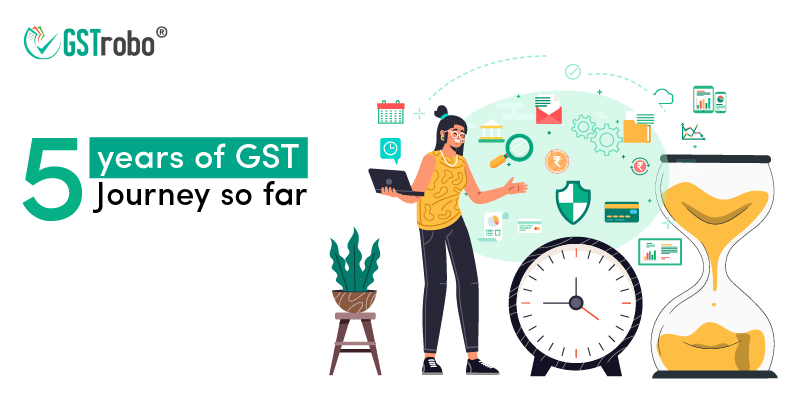Five Incredible Years of GST
On July 1, 2022, India will celebrate the 5th anniversary of the Goods and Services Tax (GST). The Central Government has named July 1st as ‘GST Day,’ which commemorates the implementation of the historic tax reform. At the time of completion of 4 years of GST, Union Finance Ministry last year sent over 54,000 appreciation letters to GST payers on GST Day for timely filing of returns and a cash payment of tax.

This blog will cover all the aspects related to the achievements of GST till now:
Goods and Services Tax (GST)
The Goods and Services Tax (GST) is an indirect and destination-based tax, levied in India on the supply of goods and services. GST merged all existing domestic indirect taxes in the nation (the notable exceptions being petroleum, alcoholic drinks, and stamp duty) under one umbrella, making it the largest tax reform in independent India’s history. The GST is taxed at every stage of the manufacturing process but is collected at the point of consumption, finally refunding all parties other than the end customer.
Success of GST
In the past five years, India’s tax base has quadrupled from 66.25 lakhs to 1.36 crores as on March 31, 2022. “The gross GST revenue collected in May 2022 was ₹1,40,885 crore, of which CGST is Rs 25,036 crore, SGST is Rs 32,001 crore, IGST is ₹ 73,345 crore (including ₹ 37,469 crores collected on import of goods), and cess is ₹ 10,502 crore (including ₹ 931 crores collected on import of goods).
In April 2022, the highest monthly GST collection was ₹ 1.68 trillion. The GST revenues in May 2022 were 43% higher than the GST revenues in the same month last year of ₹ 97,821 crores.
Recovery of Economy after Third Wave
Along with economic recovery, anti-evasion operations, particularly action against false billers, have contributed to the increased GST. The increase in revenue was also because of rate rationalization procedures implemented by the council to fix the inverted duty structure along with the increase in imports and high retail/wholesale prices.
Revenue from imports of goods was 43% higher in May 2022 when compared with the previous year, while revenue from domestic transactions (including imports of services) was 44% higher in May 2022 than in the same month the previous year.
Reduced compliances for taxpayers
Any change of this size in a country as huge and varied as India is difficult. The GST Council has demonstrated considerable foresight and judgment in addressing valid taxpayer and citizen concerns by correcting course when necessary. This is evident in steps to lower the compliance burden on taxpayers, particularly MSMEs, and the other taxpayers.
Implementation of relief programs aimed at boosting taxpayer liquidity
It is stated that the relief efforts implemented during the epidemic, which has wreaked havoc on the world and harmed the global economy, are indicative of such an approach. COVID relief packages were adopted, which comprised, among other things, late fee waivers, interest rate decrease, time restriction relaxation, and the conduct of a refund push to enhance cash in the hands of the taxpayer.
GST rates on COVID Treatment have been decreased
Furthermore, the GST rates for vaccinations, necessary medications, and COVID preventative and treatment products/services were cut. Furthermore, the REAP project’s quarterly returns and monthly payment schemes, e-invoices, and auto-population of returns have decreased the compliance load on taxpayers, making their life simpler and better.
The Central Board of Indirect Taxes and Customs (CBIC) and the State Tax Administration have been working day and night during the last 5 years, making GST a success. CBIC released a book to pay tribute to 189 officers and employees who lost their lives in the line of duty due to the pandemic and to remember their contribution to the national endeavor.
